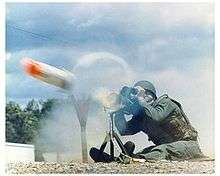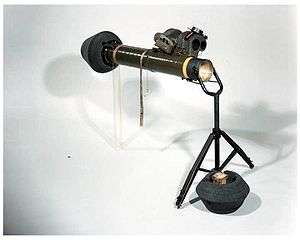M47 Dragon
| M47 Dragon | |
|---|---|
|
The M47 Dragon, shown here with its daytime tracker attached. | |
| Type | Anti-tank missile |
| Place of origin | United States |
| Service history | |
| In service | 1975–present |
| Used by | See Operators |
| Wars |
Invasion of Grenada Iran–Iraq War Persian Gulf War |
| Production history | |
| Designer | Raytheon |
| Designed | March 3, 1966 |
| Manufacturer | McDonnell Douglas, Raytheon |
| Unit cost |
$13,000 (standard) [1] $51,000 (with night tracking system)[1] |
| Produced | 1975 |
| Number built |
7,000 launchers, 33,000 missiles (U.S. Army)[2] 17,000 missiles (U.S. Marine Corps)[2] |
| Variants | Dragon II, Super Dragon, Saeghe 1 and 2[3] |
| Specifications (FGM-77) | |
| Length | 1,154 mm (45.4 in) |
| Diameter | 140 mm |
| Crew | 1 |
|
| |
| Effective firing range | 1,000 meters, minimum 75 meters |
| Maximum firing range | 1,000–1,500 meters |
| Warhead | Hollow charge |
|
| |
| Speed | 200 m/s (660 ft/s) |
Guidance system | SACLOS system sights |
The M47 Dragon, known as the FGM-77 during development, is an American shoulder-fired, man-portable anti-tank missile system. It was phased out of U.S. military service in 2001, in favor of the newer FGM-148 Javelin system.[4]
The M47 Dragon uses a wire-guidance system in concert with a high explosive anti-tank warhead and was capable of defeating armored vehicles, fortified bunkers, main battle tanks, and other hardened targets. While it was primarily created to defeat the Soviet Union's T-55, T-62, and T-72 tanks, it saw use well into the 1990s, seeing action in the Persian Gulf War. The U.S. military officially retired the weapon in 2001, although stocks of the weapon remain in U.S. arsenals.
History

Used by the U.S. Army, the U.S. Marine Corps, as well as many foreign militaries, the M47 Dragon was first fielded in January 1975 to U.S. Army soldiers stationed in mainland Europe.[5] The effective range of the Dragon was about 1000 meters, with the missile traveling 100 meters per second, guided by an infrared sight. The operator had to continue to track the missile to its target, which exposed him to enemy fire.
The principles of flight and guidance were interesting. The first oddity was the delay between snapping the trigger and the ignition of the launch motor. This was due to a chemical battery charging the initiator circuit (the operator could hear a rising whine similar to the whine made by early integrated flash cameras when charging the flash circuit). This usually led to the operator tensing up in anticipation of the sudden explosion from the launcher that he knew was coming. The missile was discharged from the launcher tube by a "launch motor", which was a rocket motor that completely expended itself within the tube so as not to injure the operator with exhaust gas. The missile coasted away from the operator and a burning infrared flare was ignited at the rear of the missile.
After the missile was about 30–50 meters from the gunner, the missile was propelled forward and guided towards the target by 3 rows of rocket propellants aligned longitudinally along the missile body. The rocket spiraled as it moved forward, and the rocket propellants were fired in pairs to move the missile forward as well as keep the missile on target. These were activated by the sight controller which sent signals from the sight mechanism to the missile along the wire which spooled out behind the missile and remained connected to the sight. The operator kept the sight crosshairs on the target; the sight tracked the infrared flare and sent corrections to the missile service motor to bring the flight of the missile to the aim point. The service charges were fired as needed both to keep the missile correcting toward the aim point and to keep it up and moving forward. A missile moving towards a stationary target and tracked by a steady gunner would fire the rockets about every .5 to 1 second, resulting in its signature 'popping' sound as it moved downrange. If the operator over-corrected his aim point beyond the service motor's capability to keep up, the missile grounded itself. Conversely, if the guidance wire broke, the missile would fire its rockets rapidly, sending the missile into a rapid ascent. This was a recoilless weapon—the launcher did not "kick" per se when fired—but the sudden loss of the 30 lb missile weight from the shoulder caused many soldiers to flinch badly enough to lose track of the target, resulting in a missile grounding.

The M47 Dragon was not particularly popular with U.S. soldiers. Because of the missile's relatively short range and signature 'popping' sound as the missile was propelled towards the target, M47 Dragon crews were expected to take heavy casualties in the event hostilities broke out between the United States and the Soviet Union in Europe.
Variants
Dragon II
Designed and upgraded from Dragon in 1985 when its penetration effectiveness was increased.
Super-Dragon
Upgraded from Dragon II in 1990, it was capable of penetrating 18 inches (450 mm) of armor at a maximum effective range of 1,500 meters.
Saeghe
Iran has reverse-engineered a version of the Dragon, the Saeghe. They displayed it in 2002 at the Defendory exhibition in Athens, when it was in mass production.[3] Hezbollah has acquired Saeghes for anti-tank and anti-armor uses.[6]
Known versions include Saeghe-1 and Saeghe-2.[3]
Components
The launcher system of the M47 Dragon consists of a smoothbore fiberglass tube, breech/gas generator, tracker, bipod, battery, sling, and forward and aft shock absorbers. In order to fire the weapon, non-integrated day or night sights must be attached. While the launcher itself is expendable, the sights can be removed and reused.
Operators


Current operators
-
 Iran[7]
Iran[7] -
 Iraq: Acquired M47 Dragons captured from Iran.[2]
Iraq: Acquired M47 Dragons captured from Iran.[2] -
 Israel[7]
Israel[7] -
 Jordan[7]
Jordan[7] -
 Morocco[7]
Morocco[7] -
 Saudi Arabia
Saudi Arabia -
 Thailand[7]
Thailand[7]
Former operators
-
 Netherlands:[7] Was replaced by the Spike in August 2001.[8]
Netherlands:[7] Was replaced by the Spike in August 2001.[8] -
 Spain:[7] Phased out of service, being replaced by the Spike.[8]
Spain:[7] Phased out of service, being replaced by the Spike.[8] -
 Switzerland[9]
Switzerland[9] -
 United States:[7] Since replaced by the FGM-148 Javelin.
United States:[7] Since replaced by the FGM-148 Javelin.
See also
- FGM-148 Javelin the successor to the FGM-77 Dragon
- BGM-71 TOW
- Shoulder-Launched Multipurpose Assault Weapon (SMAW)
- SRAW
- ERYX
- List of U.S. Army Rocket Launchers By Model Number
References
- 1 2 "M47 Dragon". 2008-01-19. Retrieved 2009-01-11.
- 1 2 3 "M-47 DRAGON Anti-Tank Guided Missile". Federation of American Scientists. Retrieved 2009-01-11.
- 1 2 3 "IRAN PRESENTS VERSION OF U.S. ANTI-TANK MISSILE". Middle East Newsline. December 3, 2002. Archived from the original on 2003-05-08. Retrieved 2009-11-17.
- ↑ Figueroa, Jose (November 21, 2000). "School of Infantry students shoot the works, herald new antitank era". Marines. Retrieved December 30, 2012.
- ↑ "Anti-Tank Missiles: M47 Dragon". Olive-Drab. Retrieved 2009-01-11.
- ↑ Riad Kahwaji (2006-08-20). "Arab States Eye Better Spec Ops, Missiles". Ocus.net. Retrieved 2009-01-10.
- 1 2 3 4 5 6 7 8 Jones, Richard D. Jane's Infantry Weapons 2009/2010. Jane's Information Group; 35 edition (January 27, 2009). ISBN 978-0-7106-2869-5.
- 1 2 "Spike Anti-Armour Missile Systems, Israel". Army Technology. Retrieved 2009-01-20.
- ↑ "PAL-System wird nach dreissig Jahren Einsatz liquidiert". Federal Department of Defence, Civil Protection and Sports. 2007-10-23. Retrieved 2016-07-09.
External links
- McDonnell-Douglas FGM-77 Dragon – Designation Systems
- Comal citizen finds M47 Dragon missile launcher in the wood
- Iranian Copies of the TOW and DRAGON
